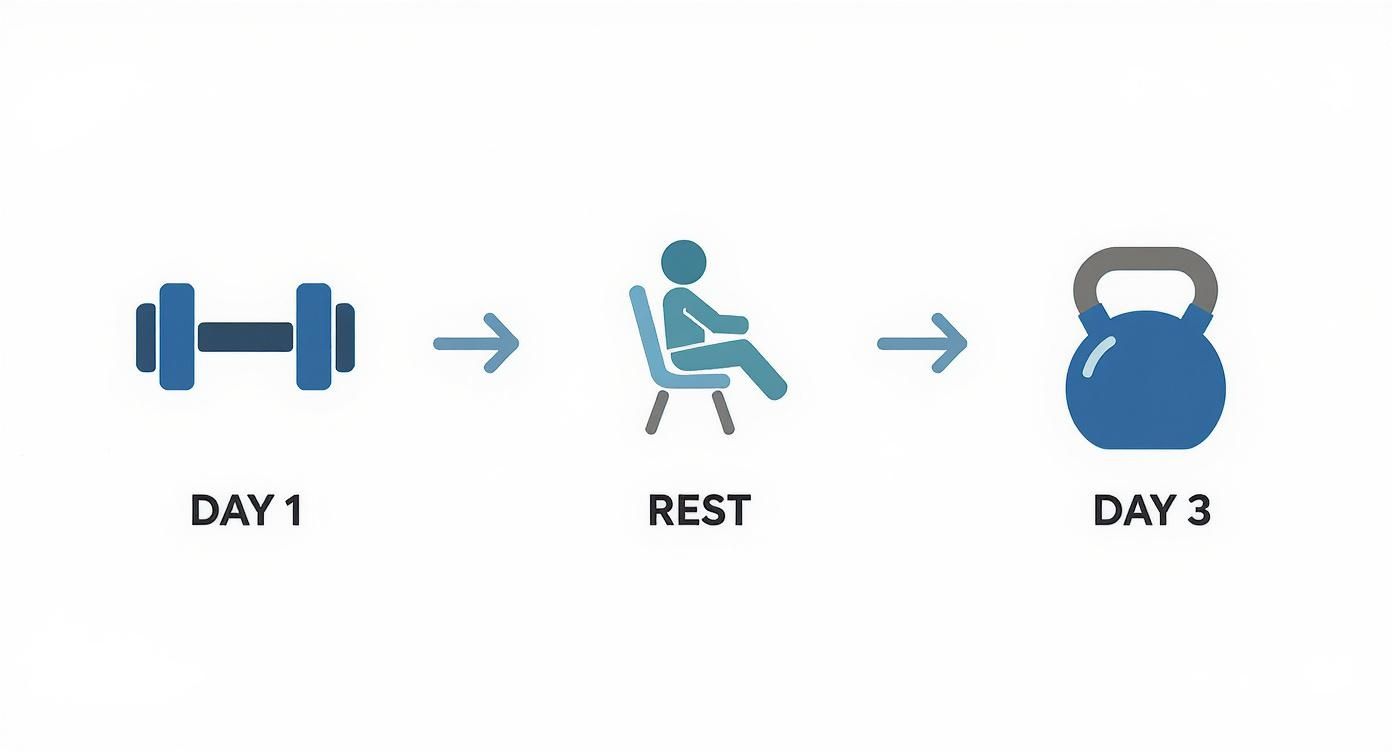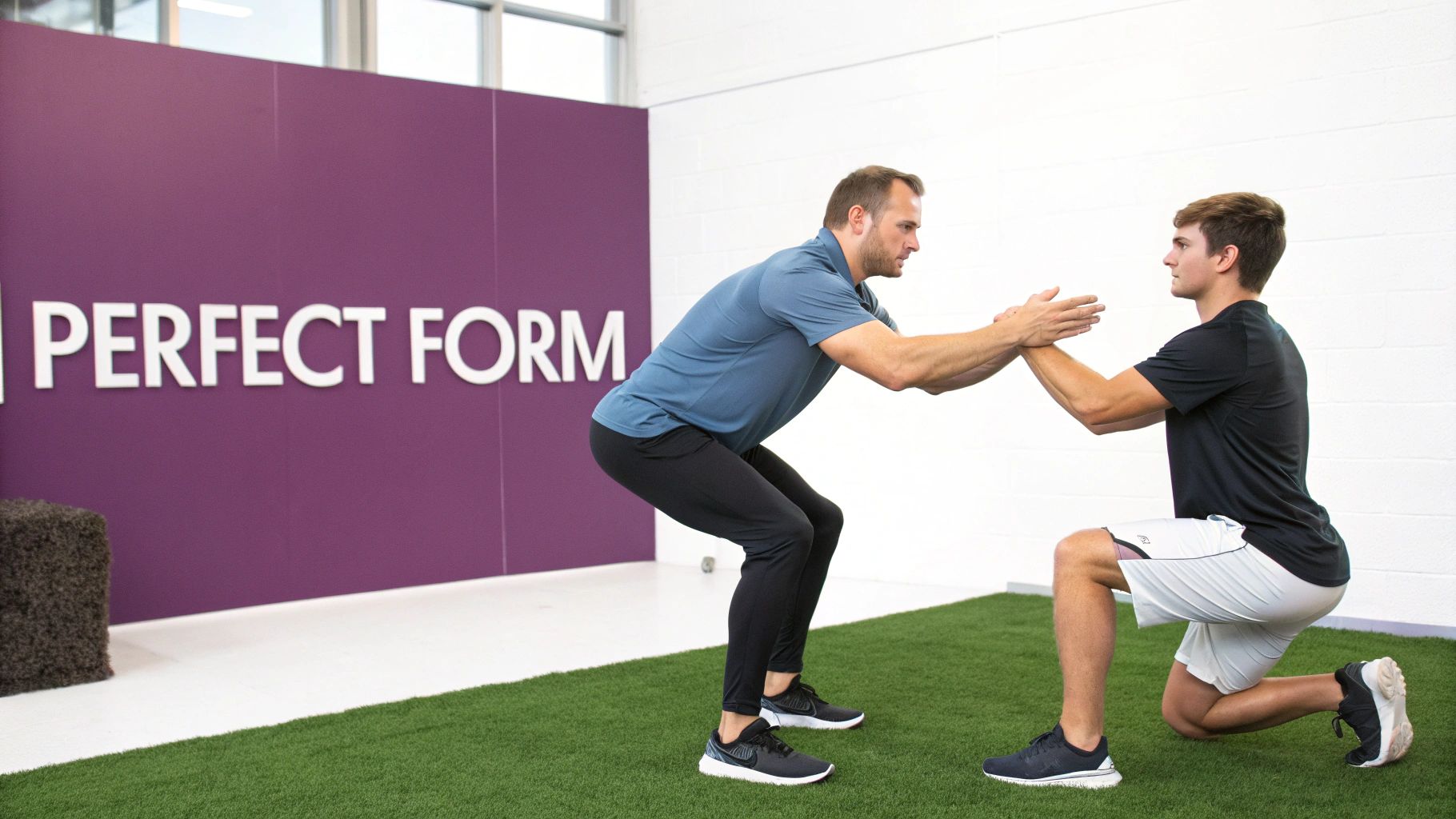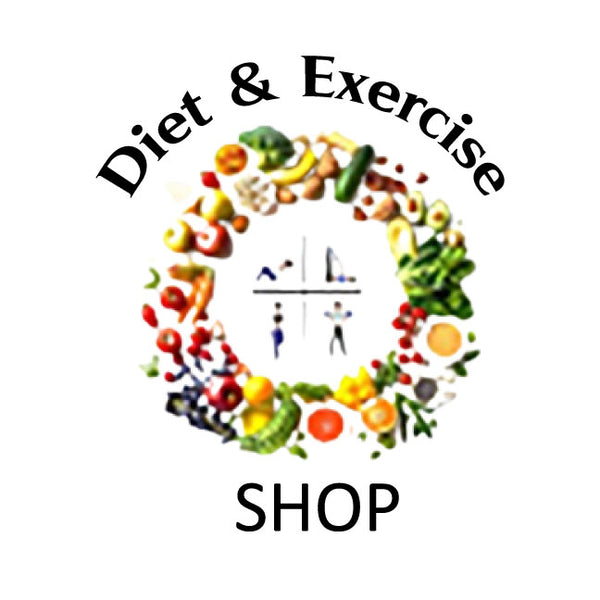
Your First Workout Routine for Beginners
A good workout routine for beginners is all about one thing: consistency. The best approach is to start with 2-3 full-body workouts a week. This builds a solid base and creates a habit you can stick with.
This guide combines the workout and diet habits you need to get started on your fitness goals. We'll show you how to begin, what gear helps, and how to fuel your body for success.
Starting Your Fitness Journey Without the Overwhelm
Jumping into a new fitness plan can feel intimidating. The secret isn't a complex schedule; it's about starting small and building momentum. Your only job is to show up consistently.
Many beginners feel overwhelmed by the gym, which is why working out at home has become so popular. Exercising in your own space, on your own time, removes a major barrier.
In fact, 51% of U.S. exercisers now prefer working out at home. This shows that a comfortable setting is key for building confidence.
Your First Fitness Steps at a Glance
| Core Principle | Why It Matters for Beginners | Actionable Tip for Today |
|---|---|---|
| Start Simple | Complex routines lead to burnout. Simplicity builds consistency. | Pick just 3-4 bodyweight exercises and do them. That's it. |
| Set Small, Achievable Goals | Big goals are daunting. Small wins build motivation and confidence. | Your goal this week: Complete two 20-minute workouts. |
| Focus on Form Over Weight | Bad form causes injury. Good form builds a strong, safe foundation. | Watch a video on proper squat form before you even try one. |
| Listen to Your Body | Pushing through pain leads to setbacks. Rest is when you get stronger. | Feeling sore? Go for a walk or do some light stretching instead. |
These principles are your compass for the first few weeks. They’ll keep you pointed in the right direction.
Setting Realistic Goals and Expectations
The key to a successful beginner workout routine is setting goals you can actually hit. Instead of "I need to lose 20 pounds," aim for "I will complete my three scheduled workouts this week."
The most effective workout plan is the one you can stick with consistently. Aim for progress, not perfection, especially in the first few weeks.
This mindset shift helps you build momentum. You’re creating a new lifestyle, not a temporary fix. For a deeper dive, check out our guide on how to start a fitness routine.
Essential Gear for Your Home Gym
You don't need a lot of equipment to get an amazing workout. Starting with a few versatile pieces is the smartest way to go.
Here are the essentials:
- Resistance Bands: Perfect for adding challenge to bodyweight moves like squats and glute bridges. They’re great for any fitness level. Our Durable Resistance Band Set is designed for beginners, with multiple levels to match your improving strength.
- Adjustable Dumbbells: A brilliant space-saver. They let you gradually increase weight as you progress, which is critical for building strength. An Adjustable Dumbbell Set is a smart investment that grows with you.
- A Quality Yoga Mat: A good mat provides cushion and support for floor exercises like planks and push-ups, making the experience more comfortable.
Having the right tools makes it easier to stay committed and see results.
Putting It All Together: Your First Weekly Workout Plan
Now, let's turn your energy into a solid plan. A good schedule is what separates wishful thinking from real results. The goal is to create a sustainable rhythm.
For most beginners, a 3-day full-body workout schedule is ideal. This gives your muscles 48 hours to rest and recover between workouts. A classic split is working out on Monday, Wednesday, and Friday.
Your 3-Day Beginner Workout Routine
This routine hits all major muscle groups. Focus on your form—five perfect reps are better than 15 sloppy ones.
Here’s a simple circuit to repeat three times:
- Bodyweight Squats (10-12 reps): Stand with feet shoulder-width apart. Push your hips back and down as if sitting in a chair, keeping your chest up.
- Modified Push-ups (8-10 reps): Start on your hands and knees. Lower your chest toward the floor, keeping your back flat.
- Banded Rows (10-12 reps per arm): Using our Fabric Resistance Bands provides the tension needed to strengthen your back muscles effectively.
- Plank (Hold for 20-30 seconds): Keep a straight line from your head to your heels. Squeeze your core and don't let your hips sag.
If you're a visual learner, watch this Beginner Full Body Workout video from the Diet & Exercise YouTube channel for a breakdown of each movement.
The point of a beginner workout is to finish feeling good, not wiped out. If it feels like too much, reduce the reps or rest longer. Listen to your body.
Don't Forget: Diet and Exercise Go Hand-in-Hand
Your workouts signal your body to change, but food provides the materials to do it. Ignoring nutrition is a surefire way to stall progress.
Think of it this way: your pre-workout snack is fuel, and your post-workout meal is the repair crew. Have a small, carb-focused snack an hour before, and a balanced meal with protein and carbs within two hours after.
The Rise of Accessible Fitness
This routine is perfect for home, fitting into a larger fitness trend. People stick with what's convenient. In 2021, 59.1% of active adults preferred outdoor exercise, while at-home equipment usage jumped to 16.7%.
This data, which you can explore in this research about fitness trends, shows your environment matters. A simple home workout routine is a powerful starting point because it meets you where you are.
Simple Nutrition to Fuel Your Workouts
Exercise tells your body to get stronger, but your food actually builds it up. You don't need a complicated diet, just smart habits that support your new fitness routine.
To keep it simple, focus on the three key macronutrients: protein, carbohydrates, and fats. Each has a specific job.

What you eat directly fuels the recovery process shown above, making rest days more effective.
Fueling Up Before You Go
Carbohydrates are your body's main energy source. Eating carbs like a banana or oatmeal about an hour before you work out gives you immediate fuel.
Protein is for muscle repair and growth. After a workout, your muscles are ready to rebuild, and protein provides the raw materials.
Healthy fats from sources like avocados, nuts, and olive oil are essential for hormone production and long-term energy.
Nailing Your Post-Workout Recovery
The first hour after a workout is a prime time for your body to absorb nutrients. A combination of protein and carbs here can dramatically speed up recovery.
A simple protein shake right after your workout is one of the easiest wins in fitness. It gives your muscles exactly what they need, right when they need it.
Our Clean Whey Protein Isolate is perfect for this. It delivers pure, fast-absorbing protein to kickstart recovery. Many people find it helps reduce soreness the next day. It's one of the best ways to combine your diet and exercise habits for faster results.
Easy Meal and Snack Ideas
Keep your pre-workout snack light. A piece of fruit or a small bowl of oatmeal works well. See our guide to the best pre workout snacks for more ideas.
After you train, eat a balanced meal within an hour or two. Think grilled chicken with a sweet potato and veggies. This restocks energy and gives muscles the protein they need.
Mastering Form to Prevent Injury and Get Results
Executing exercises with proper form is the single most important part of any workout. It's the difference between building strength and getting injured.
Good form is your foundation. It ensures the right muscles are doing the work.

Focusing on form makes the exercise more effective and protects your joints. Rushing with sloppy technique is a fast track to pain.
Common Exercises and How to Do Them Right
Let's break down two fundamental movements.
The Squat:
- Set Yourself Up: Feet slightly wider than your hips, toes mostly forward.
- Get Moving: Push your hips back like you're sitting in a chair. Keep your chest lifted and your back straight.
- Watch Out For This: Don't let your knees collapse inward. Actively push them out to stay aligned with your feet.
The Lunge:
- Set Yourself Up: Stand tall with feet together.
- Get Moving: Take a big step forward. Lower your hips until both knees are at a 90-degree angle. Your front knee should be over your ankle.
- Watch Out For This: Keep your torso upright and your core tight to stay balanced and protect your back.
Quality over quantity is the golden rule. Five perfect squats are better than 15 sloppy ones. Slow down and focus.
For a detailed walkthrough, this form-focused video on the Diet & Exercise YouTube channel is a great resource to check your technique.
How Your Gear Can Help
The clothes you wear can affect your ability to move correctly. Restrictive clothing can limit your range of motion.
That's why quality activewear is a smart move. Our Women’s High-Waisted Seamless Leggings are designed to move with your body, giving you the support and flexibility you need for perfect form.
When you feel comfortable in your gear, you can focus on your movement.
Keeping the Momentum: How to Progress and Stay Motivated
You’ve built a routine—that's a huge win. The next step is to keep the momentum going by making small, smart adjustments over time.
https://www.youtube.com/embed/lu_BObG6dj8
The secret to lasting results is progressive overload. This means you must gradually make your workouts more challenging to keep getting stronger.
Your body adapts quickly. If you do the same workout forever, your progress will stall. Progressive overload keeps your body guessing and improving.
Smart Ways to Challenge Yourself
Making workouts harder doesn't just mean adding weight. There are several ways to apply progressive overload.
Here are your options:
- More Reps: If you did 10 squats last week, aim for 12 this week.
- More Sets: Instead of two circuits, push for a third round.
- More Weight: This is the classic path. Even a small jump in weight makes a big difference over time.
- Less Rest: Cut rest time between exercises from 60 seconds to 45.
Tip: Only change one thing at a time. If you add weight, keep reps the same. This helps you progress safely.
When you're ready to add weight, an Adjustable Dumbbell Set is a fantastic investment. Instead of buying new weights, you can just dial up the resistance. It's a space-saving solution that grows with you.
Simple Ways to Level Up Your Workout
Here’s how you can apply these principles to a squat.
| Progression Method | How It Works for You | Example Using a Squat |
|---|---|---|
| Increase Reps | Builds muscular endurance and helps you master the movement. | Week 1, you do 3 sets of 10 bodyweight squats. Week 2, aim for 3 sets of 12. |
| Add Sets | Increases total workout volume for muscle growth. | You've been doing 2 sets of 15 squats. Now, push for a 3rd set. |
| Add Weight | The most direct way to build strength and muscle. | You've mastered bodyweight squats. Now hold a 10 lb dumbbell for 3 sets of 10. |
| Reduce Rest | Boosts cardiovascular fitness by increasing intensity. | You normally rest 60 seconds. This week, cut that to 45 seconds. |
Cycling through these methods keeps your body adapting.
Staying Motivated for the Long Haul
Motivation isn't always there. That’s why building habits is more reliable than waiting for inspiration.
Track your workouts in a notebook or app. Seeing proof of your progress—lifting more or doing one more rep—is an incredible feeling.
Tech can also help. Fitness wearables are used by 36%-44% of adults worldwide. As you can discover in more detail from these industry insights, these devices help create engaging workout experiences.
Set small, new goals, like holding a plank for 60 seconds. Celebrate those wins! They are the fuel that will keep you going. For a visual guide on leveling up, check out this Advanced Bodyweight Workout Circuit from the Diet & Exercise channel.
Got Questions About Starting a Workout Routine?
Stepping into fitness can bring up a lot of questions. Getting clear answers is the best way to build confidence.
Let's clear up some common questions for beginners.
So, How Many Days a Week Should I Actually Work Out?
For most beginners, 2-3 days of strength training per week is the magic number. This gives your body 48 hours between sessions to recover and get stronger.
On your "off" days, you can still be active with light cardio like a brisk walk or some stretching.
What’s the Best Workout for Someone Just Starting?
A full-body workout routine is the best way for beginners to start. It’s efficient and hits all your major muscle groups, building a balanced foundation.
Think of a full-body routine as learning basic chords on a guitar. You need to master them before you can play a full song.
Sticking to a 2-3 day full-body plan is a fantastic starting point.
How Long Should My Workouts Be?
You don't need to spend hours working out. A solid workout for a beginner should only take about 30 to 45 minutes, not including your warm-up and cool-down.
Quality of reps is more important than time on the clock. Focus on great form.
Do I Really Need to Buy a Bunch of Supplements?
No, supplements are not required. Your number one priority should be nailing your nutrition with whole foods.
Once you have a consistent habit, a supplement can be a helpful tool. A quality Clean Whey Protein can be a convenient way to help muscles recover. But it’s a supplement to a good diet, not a replacement. Master the basics first.
At Diet and Exercise, we’re all about helping you build a strong foundation with the right knowledge and gear. Our fitness products, from Adjustable Dumbbells to Clean Whey Protein, are designed to support you from day one. Find everything you need to start strong at https://dietexerciseshop.com.
